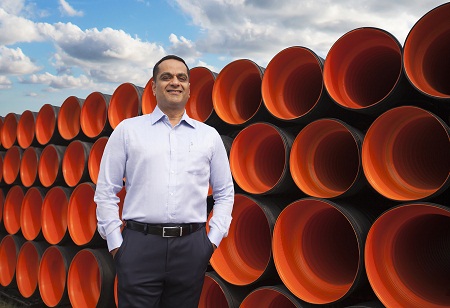
A visionary and result-oriented business leader, Parag Chheda has been felicitated with the ‘Inspiring Business Leader Award – 2016’ at the Economic Times Summit in ‘The Business and Industry category.
India is already inching towards China to replace it as the world’s most populous country. India’s water insufficiency by 2030 and the stress on new freshwater sources continue to be strongly emphasised in industry discussions. The accessibility of freshwater resources is now a major worldwide challenge. Although India has 18% of the world’s population, it only has 4% of its freshwater resources. Evidently, water is far too valuable to be used just once, with the growing needs of an expanding population.
This sets the premise for plumbing technologies of the future. While efficient water technologies are a vast theme, plumbing technologies are one of its core aspects. New plumbing trends are emerging in commercial and residential areas. Experts are developing new plumbing technologies to help solve water quality problems, reduce wastewater from plumbing fixtures, and promote sustainable consumption, keeping the future in mind.
Future trend drivers
The future of plumbing, therefore, focuses on technology, sustainability, and accessibility. And these are driving top trends to help us create more efficient and convenient plumbing systems.
Hi-tech, world-class PP piping systems
Companies with a deep heritage in India and a legacy in this industry are already taking a significant lead to usher in a new plumbing era. New sewerage and drainage technologies have been launched with silent and low-noise sewerage systems that deliver a very high level of noise insulation to the residence or commercial project.
Fluid flowing inside sewer piping can reach a relatively high-speed causing air column resonance in certain areas, which is transmitted to the building structure.
New-age sewerage and plumbing technologies offer projects several benefits of world-class products, sustainability being 100% recyclable, efficient water management, and ease of maintenance. These PP piping systems can also be adapted to a single stack drainage system instead of the conventional 3 stack drainage system, with a special fitting called an aerator. This considerably reduces the number of pipes used in a building.
Recycling systems
To ensure water recyclability, pipes are specially designed to divert wastewater generated from bathtubs, shower drains, washing machines and kitchen sinks etc.
into a system where it can be recycled to replenish depleting water resources. Such products are cost-effective, easy to install as well as UV and fire-resistant.
Upgrading to the CPVC industrial piping system
For decades, metal piping systems have dominated many industrial applications. However, these pipes have significant shortcomings, since chemicals aggressively corrode metal equipment causing process leaks, flow restriction and ultimately premature failure. Moreover, there is a high jobsite labour cost. In such applications, upgrading to the CPVindustrial piping system with high-pressure, high-temperature and high-impact strength for the transmission of chemical fluids is the most suitable long-term solution for industrial purposes.
Better filtration systems
Adapting to better filtration systems are among the most important aspects of the overall plumbing system. They block subtle elements such as chlorine or magnesium, allowing potable water consumption. The future of plumbing related to water filtration systems includes activated carbon and UV light. Activated carbon can filter smaller particles, while UV is very effective against bacteria, viruses, and parasites.
Hi-tech, sensor-based lifestyle products
Touch-free products are already being used extensively, especially in commercial restrooms. Sensor-based products are the right solution in any commercial environment and their usage has increased in the past couple of months. Although the pandemic has caused almost all major industries to evaluate how they operate, I believe, that the construction industry has got a unique opportunity to reform and embrace new-age global plumbing and piping systems.
Futuristic innovative systems with advanced technology are available in plumbing and add value to plumbers, changing the future of electricians, and technicians, and making a far deeper impact. With smart systems, water saving is increased as they automatically turn off when movement is not sensed. We see such fixtures in taps, toilets, showers, and dishwashers.
Low-flow bathrooms
Water-saving faucets and flush tanks with small flushes to reduce water discharge. Flow regulators or tap aerators regulate water flow through the tap without reducing the utility. Low-flow/flush toilets are being extensively used and will undergo more changes for efficiency and design. These systems have a unique cistern and siphon design that uses less water to remove waste.
Digital leverage in UX/CX
In addition to new products and technology, customer and user experience has started to play a significant role in industry progress and its maturity. Better customer service through the availability of trained and updated plumbers is a measure to transform the industry experience. Large companies are putting great effort into training and educating plumbers across India in new methods, soft skills, new technologies and other aspects.
With the onset of the digital age, online reviews of services & digital marketing are other key plumbing trend that will grow in use. Word of mouth used to be one of the ways to build a reputation for any business, which has now transformed into the rating and review system. Nowadays, online customer reviews play a vital role in growing a business and reaching out to a broader market. Reviews offer other customers a better understanding of a specific service and it is also an opportunity for companies to reach out to customers and discuss ways to improve their processes.
The Indian government has taken several steps in the right direction to strengthen India’s water infrastructure. I believe several opportunities exist where the industry and government can collaborate to execute key learnings from places like Singapore which has transformed its water issues with sophisticated new technologies, and advanced sewage treatment systems to improve self-sufficiency.
We use cookies to ensure you get the best experience on our website. Read more...